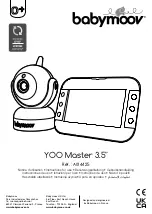
11.17
S T R A N G U L AT I O N H A Z A R D —
Children have STR ANGLED in cords.
Keep adapter cords
out of the reach of
children (more than 3
feet [0.9 meter] away)
N E V E R at te m pt to
use Sensor Pad with
o ut th e p rote c tive
cord covering. Check
protective cord covering before each use
to ensure it is securely placed under the
leg of the crib. Discontinue use of Sensor
Pad if protective covering is damaged or
broken.
11.18
Vibration Source - When the monitor
is in use, DO NOT use a crib mobile or
other crib accessories that may produce
vibrations. Other sources of vibrations
may include fans, washing machines, loud
music, etc. These sources of vibration may
interfere with the performance of your
Angelcare
®
monitor and the alarm will
not sound if it continues to detect any
movement other than your baby’s. Be sure
all vibration sources are eliminated before
using the monitor.
You may experience false alarms for several
reasons. The most common reason is the
Nursery Unit has not been turned OFF after
you have removed your baby from the crib.
Another reason is the Sensor Pad has not
been placed under the mattress properly.
Be sure the Sensor Pad is on a flat, firm
surface with the printed side facing up.
The sensitivity level may also need to be
adjusted. Refer to Step 3.1. Always be sure
to immediately check on baby whenever
an alarm sounds.
11.19
Sensor Pad - If the crib has a
spring or slat base, place a hard board
between the crib base and the Sensor
Pad measuring at least 13” x 13” (33 x 33
cm) and 1/4 inch (6 mm) thick. Only use
your Angelcare
®
monitor in a stationary
sleeping environment such as a crib where
the Sensor Pad can rest on a completely
flat, firm surface.
12. IMPORTANT SAFETY INSTRUCTIONS
RELATED TO USE OF BATTERIES
12.1
Use ONLY the type and size of
batteries specified in the owner’s manual.
There is a risk of explosion if batteries are
replaced with an incorrect type.
12.2
DO NOT use rechargeable batteries
in the Nursery Unit. Use alkaline batteries
ONLY.
12.3
DO NOT dispose batteries in fire. They
may explode. Check with local regulations
for possible special disposal instructions.
12.4
Exercise care in handling batteries
in order not to short out the batteries
with conducting materials such as rings,
bracelets and keys. Overcharging, short
circuiting, reverse charging, mutilation, or
incineration of batteries must be avoided
to prevent one or more of the following
occurrences: release of toxic materials,
release of hydrogen and/or oxygen gas,
rise in surface temperature.
12.5
DO NOT attempt to rejuvenate the
batteries provided with or identified for
use with this product by heating them.
Sudden release of battery electrolyte may
occur, causing burns or irritation to eyes
or skin.
12.6
If and when necessary, the batteries
must be replaced with identical new ones
or equivalent (volts and size). If a battery
to be replaced is connected with other
batteries in series, replace the other
batteries at the same time as well. DO
NOT mix old and new batteries.
12.7
Reverse polarity installation of the
batteries in the end product must be
avoided. Reverse insertion of batteries
can cause charging, and that may result
in leakage or explosion.
12.8
Remove batteries from this product
if you store the product over 30 days
because the batteries could leak and
damage the product.
12.9
Discard ‘dead’ batteries as soon as
possible since ‘dead’ batteries are more
likely to leak in a product. If a battery has
leaked or vented, it should be replaced
immediately using protective gloves.
12.10
DO NOT store this product, or the
batteries provided with or identified for
use with this product, in high-temperature
areas.
5
E
N
01mf4_ManuelAC300_NA_12010.indd 5
2015-03-17 3:41 PM






































